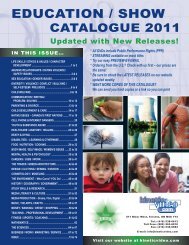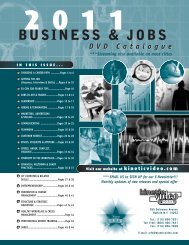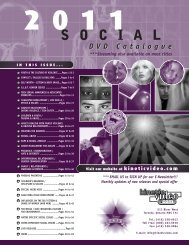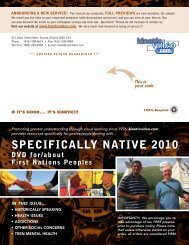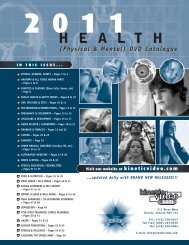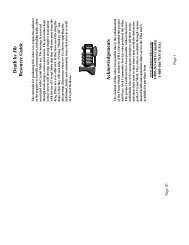WHAT'S NEW @ KINETIC???!!! - Kinetic Video
WHAT'S NEW @ KINETIC???!!! - Kinetic Video
WHAT'S NEW @ KINETIC???!!! - Kinetic Video
You also want an ePaper? Increase the reach of your titles
YUMPU automatically turns print PDFs into web optimized ePapers that Google loves.
BIOTECHNOLOGY IN THE 21ST CENTURY - Biotechnology is revolutionizing life in the 21st century, but with every<br />
breakthrough comes controversy. Do the benefits of stem cell technology, gene-splicing, and other advances outweigh the<br />
risks? Using interviews with experts, footage of scientists at work, 3-D animations, and on-screen text, this balanced series<br />
introduces viewers to a field of science - and the pressing issues associated with it - that is rapidly changing the world.<br />
BIOINFORMATICS, GENOMICS, AND PROTEOMICS: Getting the Big Picture - If the 20th century was the era of physics and<br />
nuclear fission, the 21st belongs to the life sciences. Moving from gene, to genome, to genetically based diseases, this<br />
program provides an overview of the interrelated fields of genomics, proteomics, and bioinformatics, with an emphasis on<br />
practical applications of biotechnology to the field of medicine. Are genetically personalized drugs around the next corner?<br />
BIOTECHNOLOGY AND YOUR HEALTH: Pharmaceutical Applications - Scientists have come a long, long way since Alexander<br />
Fleming’s discovery of penicillin, the wonder drug of the 20th century. This program explains the function of infectionfighting<br />
antibiotics; vaccinations and insulin, crucial to the prevention of diseases such as smallpox and the management of<br />
diabetes; recombinant drugs, treatments involving genetically engineered DNA; and stem cells, those chameleon-like building<br />
blocks of the body. 24 minutes<br />
BIOTECHNOLOGY ON THE FARM AND IN THE FACTORY: Agricultural and Industrial Applications - As the world’s population<br />
and overall standard of living continue to increase, the growing demand for food, fuel, and consumer products has reached<br />
unprecedented levels. This program examines how biotechnology is helping to meet those needs through genetic engineering<br />
to increase crop yields and improve the nutritional value of key staple foods; animal agriculture, founded on selective<br />
breeding and edging toward lab-based genetic engineering; and industrial applications<br />
of biotech in the manufacturing of chemicals, textiles, beverages, and fuel.<br />
THE ETHICS OF BIOTECHNOLOGY - The Nuclear Age - sprung upon the world with the<br />
atomic bomb - remains a bitter memory. How biotechnology, with its power to change<br />
life on Earth at the most fundamental level, will be viewed in the decades to come<br />
depends on decisions being made right now. This program confronts viewers with<br />
some of the ethical and moral implications of cloning, stem cell research, and animal<br />
testing. 24 minutes<br />
#12540/0635 Four programs 2009 $129.95 each or Series $479.95<br />
ESSENTIAL CHEMISTRY SERIES<br />
Filmed at Widener University and the Chemical Heritage Foundation, this fiveprogram<br />
series spotlights foundational aspects of chemistry that every science student needs to know. Footage of laboratory<br />
experiments reinforcing important concepts, sophisticated animations illustrating technical points of discussion, and<br />
commentary by experts passionate about science.<br />
ATOMS, MOLECULES, AND COMPOUNDS - All matter in the observable universe - from a single blade of grass to a planet in a<br />
faraway galaxy - is made up of atoms, molecules, and compounds. This program introduces these minuscule building blocks in<br />
five sections: The Nucleus (protons and neutrons, energy shells, binding energy, fission and fusion); The Electrons (quantum<br />
numbers, spdf orbitals); The Elements (periodic table, valence electrons, ions and ionization energy, electronegativity,<br />
covalent and ionic bonds); The Energy of Atoms (exothermic and endothermic reactions, spontaneous reactions, Gibbs free<br />
energy, activation energy, catalysts); and Common Compounds (properties of sodium chloride and water, polarity).<br />
CHEMICAL REACTIONS - What do fireworks, a fried egg, and a rusting truck have in common? They all involve chemical<br />
reactions. This program illustrates the mechanics of chemical reactions in five sections: Chemical Reactions (reactants and<br />
products, state changes, diatomic elements and molecules, Law of Conservation of Mass); Chemical Bonding (Octet Rule,<br />
ionic and covalent bonds); Types of Chemical Reactions (synthesis and decomposition reactions, single and double<br />
displacement reactions, acid/base reactions, exothermic and endothermic reactions); Reaction Rates (moles, kinetic energy,<br />
solutes and solvents, catalysts, activators and inhibitors, enzymes); and Reactions All Around Us (photosynthesis and<br />
chemosynthesis, autotrophs and photoautotrophs, bioluminescence). 28 minutes<br />
METALS - On the periodic table, three-quarters of all the elements are classified as one sort of metal or another. Divided<br />
into five sections, this program provides a thorough overview of metals: Metals in Our World (includes iron, lithium,<br />
magnesium, mercury, potassium, silver, sodium, uranium, zinc); Alkali Metals (history and properties of lithium, sodium,<br />
potassium, rubidium, cesium, francium); Alkaline Earth Metals (history and properties of beryllium, magnesium, calcium,<br />
strontium, barium, radium); Transition Metals (properties of iron, cobalt, nickel, copper, silver, gold, zinc, cadmium,<br />
mercury); and Metals and Chemical Reactions (exothermic and endothermic reactions, oxidation and combustion reactions,<br />
acid/base reactions). 26 minutes<br />
THE PERIODIC TABLE - Much more than a list of elements, the periodic table is a snapshot of how matter is organized on<br />
Earth and throughout the universe. In five sections, this program looks at the history and components of the periodic table:<br />
The History of the Periodic Table (from the atomos of Democritus to the atoms of Mendeleev); Metals (how to read the<br />
periodic table, transition metals, alkali metals, alkaline earth metals); Lanthanides, Actinides, and Transuranium Elements<br />
(properties of lanthanides and actinides, transuranium and transfermium elements); The BCNOs (properties of metalloids,<br />
other metals, and nonmetals); and Halogens and Noble Gases (properties and applications of halogens and noble gases).<br />
STATES OF MATTER - This program scrutinizes the concept of phase transitions - from naturally occurring changes in state to<br />
those created in laboratories - in five sections: Solids, Liquids, and Gases (properties of molecules in different states;<br />
hydrogen bonds, dipole-dipole forces, dispersion forces; effects of temperature, pressure, and volume on atomic and<br />
molecular movement; Ideal Gas Law); Evaporation and Condensation (intermolecular forces, boiling/condensing point,<br />
endothermic reactions); Melting and Freezing (melting/freezing point, ionic and covalent bonds, cations and anions);<br />
Sublimation and Deposition (triple points and phase diagrams); and Other States of Matter (plasma, liquid crystals, Bose-<br />
Einstein condensates, superfluids and supersolids).<br />
#12909/0635 Five programs 2009 Includes Guides $129.95 each or Series $598.95<br />
92





